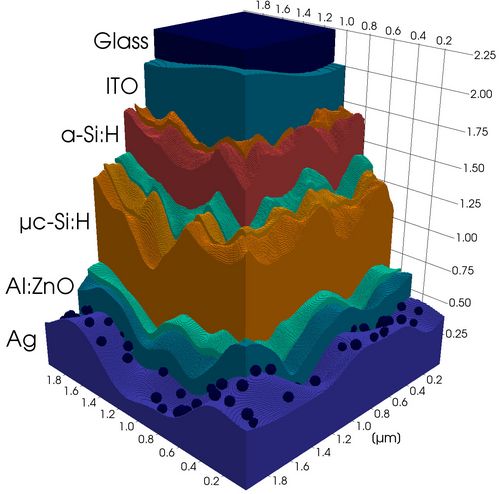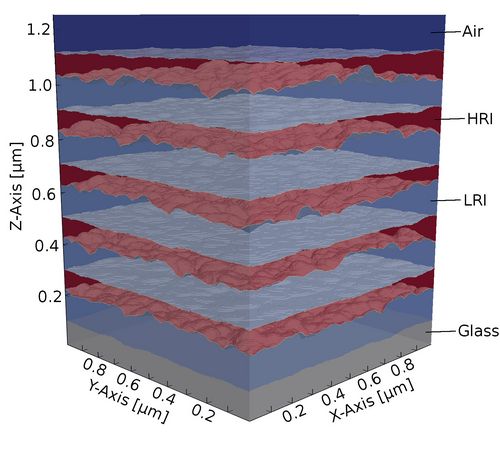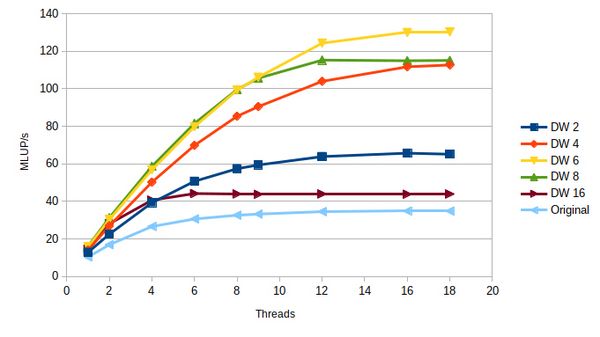MATERIALS SCIENCE AND CHEMISTRY
Optical Simulation of Innovative Thin Film Solar Cells
Principal Investigator:
Christoph Pflaum
Affiliation:
Department of Computer Science, University of Erlangen-Nürnberg (Germany)
Local Project ID:
pr87fe
HPC Platform used:
SuperMUC and SuperMUC-NG of LRZ
Date published:
Introduction
Within this project the goal is to study and develop novel approaches to boost the performance of thin film solar cells. For this, 3D optical simulation of the photovoltaic devices is performed by discretizing Maxwell’s equations.
A sophisticated light management is important to construct thin-film solar cells with optimal efficiency. The light management is based on suitable nano structures of the different layers and materials with optimized optical properties. The design, development and test of new solar cell prototypes with respect to an optimal light management are time consuming processes. For this reason, suitable models and simulation techniques are required for the analysis of optical properties within thin-film solar cells.
Methods
In order to predict optical properties of thin film solar cells, a rigorous analysis by a discretization method for Maxwell’s equations is needed. Rigorous EMF simulation methods are more accurate because they include physical effects like wave interference, reflection, scattering, as well as plasmonic effects. Suitable discretization methods are the finite integration technique (FIT) and the finite difference time domain method (FDTD). These simulation techniques are computationally intensive because the random textures at the interface of composite layers are difficult to simulate.
We have developed a simulation tool, based on finite integration technique FIT, for calculating external quantum efficiency and short circuit current density of thin film solar cells. We use FIT, because it can accurately model curvilinear interfaces and is less computationally intensive compared to FEM. The program is parallelized using MPI and OpenMP and can be used on supercomputers with several thousand processors.
Simulation Results
Flexible Silicon Tandem Solar Cells
The Silicon based Thin Film Flexible Solar cells project (SiSOFlex) was envisioned to use the advantages of thin film solar cells and work on different weak aspects of the solar cell to achieve a stable and working solar cell with >11% stable efficiency. To achieve this goal, simulation, modeling, and optimization of different ideas and concepts play an integrated role along with experiments before going in production. Figure [1] shows the cross section of such a solar cell. The roughness of the surfaces and the integration of scattering particles results in an optimized harvesting of the incident light. Optimization of those structures requires many simulations but allows for an accurate prediction of the performance of the resulting solar cells. More detailed results can be found in Ref. [2].

Figure 1: Cross-section of an exemplary simulation setup of a tandemthin-film solar cell. The amorphous (aSi:H) and mi-crocrystalline silicon(μc-Si:H) layers have textured surfaces to increase the light trappingability of the cell. SiO 2 nanoparticles are incorporated to further increaselight scattering at the bottom electrode (Ag). © FAU
Plasmonic Absorption Enhancement
The excitation of localized surface plasmons on metallic nano particles results in an enhancement of the electromagnetic field in the direct vicinity of the particles. The origin of this effect is the oscillation of the electron cloud in the metallic particles caused by the electric field of the incident light. The resulting field enhancement is perpendicular to the polarization of the incident electric field, see Figure [3]. Experimentally it is extremely difficult to measure the near field absorption enhancement of such nano particles. Hence we are carrying out simulations to study the impact of several particle types and arrangements incorporated into thin film organic photovoltaic devices.
Wavelength Selective Dielectric Mirrors
Organic photovoltaics in combination with dielectric mirrors (DM) are a potential candidate for building integrated solar cells as they promise high efficiencies in parallel to the possibility to adjust the color and the transparency of the whole device. Wavelength selective filters which are also known as 1D photonic crystals, Bragg mirrors, or DM are based on constructive or destructive interference in thin layers. For this purpose, a high refractive index (HRI) and a low refractive index (LRI) material have to be arranged alternatingly. Comparison to experimental measurements have shown that a good agreement can be reached with our simulation code. Figure [2] shows a simulation setup of a DM with five alternating HRI/LRI layers. The characteristic transmission spectrum of a DM depends not only on the used materials but also on the surface roughness between the HRI and LRI layers. This makes 3D optical simulations necessary.
Performance Optimization
Single Node Optimization
In order to optimize the single node performance of the used simulation tool, a KONWIHR project at the RRZE (Regionales Rechenzentrum Erlangen), FAU Erlangen-Nürnberg, was carried out. We implemented a multi-core wavefront diamond blocking scheme with multi-dimensional intra-tile parallelization, see [4]. With this temporal blocking method we were able to boost single node performance by a factor of 3 to 4, see Figure 3. The originally highly memory bound stencil code saw a reduction in main memory bandwidth between 40% and 80%.
Multi Node Optimization
Were able to reduce the time spent on data exchange between processes by an improved mapping of the processes to the simulation grid and by more sophisticated overlapping/asynchronous data exchange algorithms. The benchmarks show that we were able to improve the parallel efficiency of the simulation code from ~70% up to >90% for more than 100 compute nodes.
References and Links
[1] https://www.cs10.tf.fau.de/
[2] www.eupvsec-proceedings.com/proceedings?fulltext=abebe
[3] Bronnbauer, C., Hornich, J., Gasparini, N., Guo, F., Hartmeier, B., Luechinger, N. A., Pflaum, C., Brabec, C. J. and Forberich, K. (2015), Printable Dielectric Mirrors with Easily Adjustable and Well-Defined Reflection Maxima for Semitransparent Organic Solar Cells. Advanced Optical Materials, 3: 1424–1430. doi: 10.1002/adom.201500216
[4] Malas, T. M., Hornich, J., Hager, G., Ltaief, H., Pflaum, C., and Keyes, D. E., “Optimization of an electro-magnetics code with multicore wavefront diamond blocking and multi-dimensional intra-tile parallelization,” in [2016 IEEE International Parallel and Distributed Processing Symposium (IPDPS) ], 142–151 (May 2016).
Research Team
Julian Hornich M. Sc., Prof. Dr. Christoph Pflaum (PI)
Scientific Contact
Prof. Dr. Christoph Pflaum
University of Erlangen-Nürnberg
Computational Engineering
Department of Computer Science
Cauerstraße 11, D-91058 Erlangen (Germany)
e-mail: christoph.pflaum [@] fau.de
Web: www10.informatik.uni-erlangen.de/~pflaum/
NOTE: This report was first published in the book "High Performance Computing in Science and Engineering – Garching/Munich 2018".
LRZ project ID: pr87fe
April 2020

